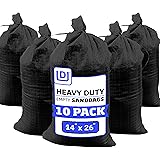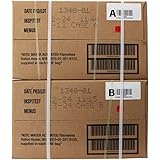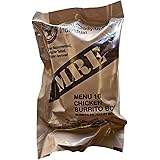The Top 10 Survival Foods for Long-Term Storage
- Long-Term Food Storage Essentials
- Best Canned Foods for Survival
- Nutritious Grains for Emergencies
- High-Calorie Snacks for Survivalists
Long-Term Food Storage Essentials
Understanding Food Preservation
When it comes to long-term food storage, the first thing I learned is that preservation techniques are key. From dehydration to canning, there’s a whole world out there of methods you can dive into. I remember the first time I attempted to can my own fruits. Let me tell you, it was a learning curve! But I eventually found the sweet spot between taste and longevity.
Using vacuum-seal methods for storing food is another brilliant way to prolong the shelf life. You’d be amazed at how much you can save by sealing up your meal preps. I once sealed a bunch of my favorite chili, and it lasted for months in the freezer without losing its flavor. Talk about a win!
Lastly, understanding the shelf life of different foods makes a monumental difference. Some stuff can last decades, while others might need to be consumed within a year. It’s all about picking the right foods if you want to survive in a pinch.
Choosing the Right Containers
Containers can make or break your food storage game. I learned early on that the quality of the container has a huge impact on food longevity. Glass jars, for instance, are fantastic for dry goods, while mylar bags are great for long-term storage of grains and legumes. I even use food-grade buckets, which are super versatile!
Labeling your containers is another essential practice. Honestly, without clear labels, you’ll end up playing a guessing game with your food inventory. I’ve been in situations before where I had no idea what I was pulling out of the back of the closet, and it wasn’t pretty.
Don’t forget about climate control too! Keeping your food in a cool, dark space can dramatically extend its shelf life. Think of it as giving your food a cozy home where it can thrive.
== > What if ... Get a FREE Subscription to PREPARE
Creating a Balanced Stockpile
So, what’s a stockpile without a balance? This part has been crucial during my planning phases. I tried to think of my food supply like a well-rounded meal. You’ll want to ensure you include proteins, carbs, and fats.
I usually make a list of my favorite meals and their components, which helps me visualize what I need to stock. For instance, if I love chili, I can get canned beans, tomatoes, and cornbread mix. Easy peasy!
Lastly, re-evaluating your stockpile regularly makes a world of difference! I like to rotate my inventory and use the earliest-expiry items first. It’s like a little inventory management hobby I have, ensuring freshness while keeping my meals appetizing.
Best Canned Foods for Survival
Variety is the Spice of Life
One can’t survive on green beans alone, am I right? I pay a lot of attention to variety when choosing canned foods. For my last emergency prep, I got everything from black beans to canned peaches. The better variety you have, the more you can mix it up and keep meals interesting.
Making sure you have proteins is crucial too. Canned chicken or tuna can be a lifesaver. I’ve made some delicious pasta salads on the fly when I needed a quick meal and had some canned chicken on hand—talk about easy cooking!
Don’t forget about soups and stews; they often include a mix of nutrients. There are so many options, and they’re great for a quick dinner that feels hearty and fulfilling.
Reading Labels Properly
You might think canned foods are all created equal, but trust me, they’re not. I learned the hard way to look for low sodium and no added sugars. Some companies sneak in a whole bunch of unnecessary ingredients, and you’d rather skip that for your long-term storage.
Also, check for BPA-free cans! This might seem minor, but it can impact your health in the long run. Once I started being more mindful about the quality of my canned foods, I noticed I felt better overall after meals.
Lastly, I also pay attention to the expiration dates. Just because you can store food for a long time doesn’t mean it’s good to eat forever. Checking those dates ensures I have safe, tasty meals when the time comes.
Optimizing Your Canned Food Choices
One of my favorite hacks for finding the best canned food is shopping at local farmer’s markets or joining food co-ops when possible. They often have organic options that taste way better than the typical supermarket stuff. Plus, supporting local businesses feels good too!
Consider creating meals that can use multiple canned items. I love preparing a simple casserole that pulls together different canned goods, making a true hodgepodge of nourishment. The family’s never turned down a home-cooked meal like that!
Finally, don’t be afraid to experiment. I’ve tried mixing up different canned products and inventing my own meals. Some have turned out a little strange, but others ended up being a hit. You won’t know until you give it a go!
Nutritious Grains for Emergencies
The Power of Whole Grains
Grains are the backbone of any survival food stockpile. I quickly learned that whole grains, like brown rice and quinoa, are nutrient-dense and keep you feeling fuller longer. There’s just something comforting about a warm bowl of grain after a long day.
I can’t stress enough how versatile grains are. Not only can you serve them as a side dish, but they also serve as the base for salads and stir-fries. Love rice bowls? Me too! Just toss in some canned veggies and proteins, and you have a meal.
And let’s not forget storage! Grains can be sensitive to moisture, so finding the right containers to keep them dry is essential. Airtight containers are my go-to for maintaining that freshness over the months.
Storing Grains Wisely
When I first started storing grains, I didn’t know much about pests. I soon realized the importance of storing grains in a cool, dark place—plus, adding oxygen absorbers helps keep them fresh and pest-free.
I’ve also found that freezing grains for a short period can kill off any potential bug eggs before you store them long-term. It might seem like extra work, but I promise it’s worth it to have peace of mind later.
Rinsing grains before cooking can help enhance their flavor. I do this quite a bit, and you’ll notice the difference once you start practicing it!
Combining Grains for Nutritional Power
I love experimenting with different grain combinations! For instance, mixing quinoa with bulgur can create a robust, protein-packed meal. Not only do they add a great flavor, but they also contribute to a more complete nutritional profile.
Planning a grain-based meal is often where my creativity shines. I combine grains with various beans and spices to create mouthwatering meals. The possibilities are endless, and it keeps things exciting!
Last bit of advice: Keep a variety of grains on hand. Brown rice, oats, and pasta are all great staples. Having them allows you to mix and match and create new dishes each time!
High-Calorie Snacks for Survivalists
Snacks for the Win
High-calorie snacks are an unsung hero of survival food. I cannot stress enough how essential they are to maintain energy levels during tough times. Think about it—when you’re out working hard or exploring in survival mode, you need that quick energy boost!
Energy bars, nuts, and trail mixes are my go-to sources. They pack a punch in terms of calories without weighing you down. I’ve spent hours hiking with just a handful of trail mix and have never felt more energized!
Don’t forget about peanut butter! Storing jars of that creamy goodness can provide a ton of energy! Just add it to crackers, fruits, or eat it straight. Trust me; it’s a survivalist must-have!
Best Types of Snacks to Store
When stocking up on snacks, I recommend looking for items with a good mix of proteins, carbs, and fats. Jerky, for example, is a fantastic high-calorie protein source. I’ve munched on it during road trips; it’s easy to pack and always satisfies my hunger.
Another snack to consider is granola. A high-calorie granola can be convenient mixed with yogurt or even eaten plain. I love a sweet and crunchy snack that gives me that burst of energy!
Lastly, don’t underestimate the power of dried fruits! They pack a lot of nutrients and calories into small packages. I often mix them in with my trail mixes for a sweet kick that keeps me going during long hikes.
Storing and Rotating Snacks
Storing snacks can sometimes is overlooked. I like keeping my snack stash organized so I can access it quickly when hunger strikes. Designating a specific area in your pantry or storage room can save you a lot of hassle later on.
Also, reaching for snacks that have longer shelf lives is smart. I usually look for vacuum-sealed options or various brands that specialize in survival foods. You can find treasures that last a while!
And guess what? Just like with your other food items, rotating snacks is key. I have a system where I ensure the older items get eaten first. I’ve got my family on board because no one wants to munch on stale snacks!
FAQ
What are the best types of canned foods for long-term storage?
The best types of canned foods for long-term storage include proteins like canned chicken or tuna, vegetables, fruits, soups, and stews. They offer nutritional variety and can last several years if stored correctly.
How can I ensure my grains last a long time?
To ensure your grains last a long time, store them in a cool, dark place in airtight containers. Adding oxygen absorbers can help keep them fresh, and freezing them briefly can eliminate pests.
Why are high-calorie snacks important for survival situations?
High-calorie snacks are essential in survival situations because they provide quick energy when breaking down food takes longer. They help maintain energy levels during physically demanding times.
What should I consider when choosing survival foods?
When choosing survival foods, consider shelf life, nutritional content, variety, and packaging. Focus on foods that provide a balanced diet, are easy to prepare, and fit your taste preferences.






